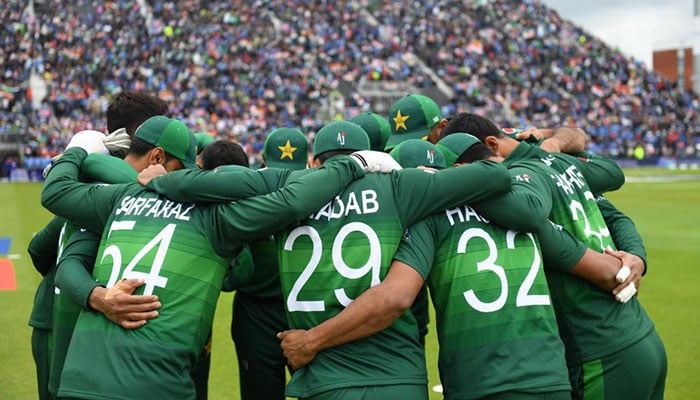Where does Pakistan Go From Here?

There is almost a month remaining of the Cricket World Cup currently being held in England and Wales, and the Pakistan side still has almost half of its matches to go. However, such have been the sorry results of the men in green that their tournament is already almost over. With just one win (a giant upset against hosts and favourites England) from five matches, Sarfaraz Ahmed’s team faces a gigantic task to reach the semifinals.
After the crushing defeat to arch-rivals India, Sarfaraz had spoken of how winning all their remaining matches could take the team to the knockouts. Unfortunately for him, he was only half right. Beating New Zealand, South Africa, Bangladesh and Afghanistan in their remaining four matches would leave Pakistan with ten points. However, in order to qualify they would need other teams to lose matches as well. Australia and New Zealand are the two most likely sides that Pakistan would be competing for a spot with. The defending champions Australia have a much easier schedule, while New Zealand take on England, Australia, Pakistan, South Africa and the West Indies. Not only would Pakistan need to win all four matches, they would need the currently undefeated Kiwis to lose four out of five matches.
This scenario doesn’t take into account Bangladesh’s current run, who mounted a record chase against the same West Indian attack that had dismissed Pakistan for the tournament’s lowest score. Mashrafe Mortaza’s team would fancy their chances to make the semifinals, and are already on two wins compared to Pakistan’s one. Furthermore, given how poor Pakistan’s net run rate (NRR) is, they can’t afford to finish with the same number of points as another team.
With Shoaib Malik woefully out of form, the call should be to replace him with Haris Sohail or Asif Ali. Photo: AFP
Some might point to how the 1992 World Cup side, which famously won the tournament, faced a similar scenario, right down to needing other teams to lose. However, in that case they weren’t counting on one of the tournament favourites to lose four out of five matches, already a major ask. On top of that, the 1992 side was a mix of legendary veterans and young players who largely were yet to make their mark. In contrast, the main young players in this side - Fakhar Zaman, Babar Azam, Shadab Khan, Imad Wasim, Hasan Ali - all announced themselves to the world in Pakistan’s Champions Trophy win two years ago, and it can be argued that Babar apart, none of them have progressed much since, with Hasan Ali facing an alarming loss of form. Moreover, the veterans in this side have struggled to pull their weight, with Shoaib Malik in particular looking woeful.
Nevertheless, if Pakistan are to mount a miracle, they would need to start by choosing their best XI. The top three of Fakhar, Imam-ul-Haq and Babar have struggled to score at top pace, but have offered a lot of consistency. The middle order has been the most vexing spot, as the combination of Mohammad Hafeez, Sarfaraz Ahmed and Shoaib Malik has failed to click. With Malik the most out of form, the call should be to replace him with Haris Sohail or Asif Ali. The former reduces the chances of a collapse, while the latter provides Pakistan’s only option for big hitting. There is little doubt that regardless of conditions, both Shadab and Imad should be played for the control they bring as well as the fact that Pakistan’s pace attack is far too inexperienced. Playing both would allow for three pacers, in Wahab Riaz, Mohammad Amir and Hasan Ali.
Tactically Pakistan would need to think of attacking in ways that they can restrict opposition sides, as the team struggles to score big, especially while chasing. Focusing on attacking with the bowling might help the team to overcome that gap. However, that’s easier said than done as the bowling has looked woeful in the tournament so far. Using Hafeez’s spin for a few overs might be one way of reducing Hasan Ali’s burden, who has looked the weakest of the bowlers yet might benefit from reduced responsibility.
There are only so many players that can be replaced, and Imad Wasim apart there are no obvious choices for captain. Photo: AFP
Speaking realistically however, with reports of dressing room infighting emerging after the India loss, it seems quite likely that Pakistan will finish second last in this tournament. If that happens, a hard reset on the team seems likely, with many heads to roll. The problem with such an approach is that there are only so many players that can be replaced, and Imad Wasim apart there are no obvious choices for captain. Even Imad has not too much experience leading, though he was recently captain of a PSL side. Coach Mickey Arthur is also likely to find himself on the firing line, and given how much focus there had been on building up to this tournament when he was hired, it seems that he might be given much of the blame.
However, it would be foolish to just look at this squad and coaching setup and think the problem ends there. Pakistan cricket has faced a decade in exile which has hurt it a lot, but its antiquated and irrational domestic system needs a crucial overhaul. A giant setup with mismatched teams, pitches that discourage shot making or high skill bowling, few facilities for learning new skills and a lack of steady money are all issues that need addressing. However, the recent outcry when the board tried to remove corporate-backed departmental sides was a reminder of just how entrenched the old ways are. Prime Minister Imran Khan, who led the team to the World Cup in 1992, would need to be bold and decisive to push through widespread changes, as multiple regimes have shown that the PCB alone is not capable of it.
In many ways, the situation looks quite bleak for Pakistan cricket. Perhaps the biggest cause for optimism might be that things can only get better from here.










No comments